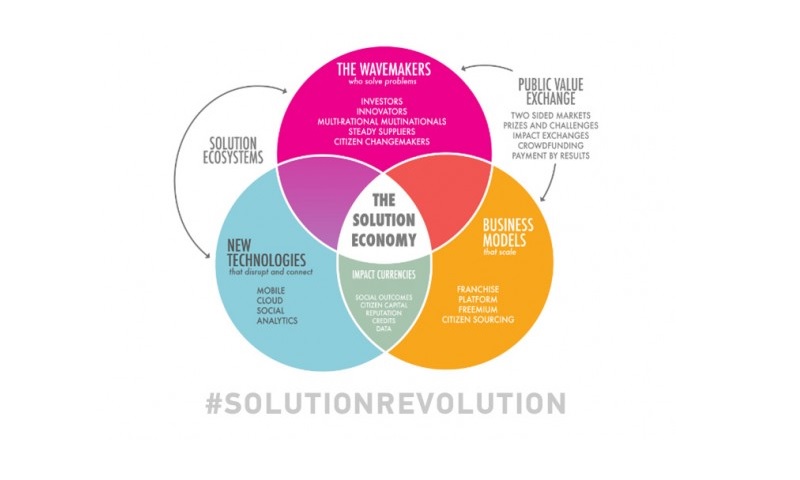
1. In your book The Solution Revolution, what is the “solution revolution” and what is the “solution economy”?
The Solution Revolution refers to a burgeoning new economy where players from across the spectrum of business, government, philanthropy, and social enterprise converge to solve big problems and create public value. Over the last decade, new players – or wavemakers - have taken on the task of tackling pressing societal problems. Acumen and Ashoka, Kiva and Kaggle, Zipcar and Zimride, Recyclebank and Terracycle, SpaceX and M-Pesa, Branson and Bloomberg, Omidyar and Gates—the list is long and growing briskly. These wavemakers see complex societal problems as economic opportunities instead of intractable challenges left up to governments to address alone. They operate in what we call the Solution Economy, where they create markets for solutions instead of dollars, and fill the gap between what governments can provide and citizens need.
2. What are the main elements of the solution economy?
First, are the wavemakers that are changing conventional beliefs and practices. These social innovators utilize disruptive technologies to develop new business models that scale to enable radically new solutions to old problems. Next are the impact currencies, from open data to carbon credits, which channel additional resources (beyond the strictly monetary) towards addressing an issue, enabling a more diverse set of contributors to be part of the problem solving. Public value exchanges such as prizes and challenges provide the platforms that tap into the creative capacity of larger populations, connecting innovators to funders of social outcomes. Lastly, these elements all come together in the form of solution ecosystems where wavemakers team up to solve problems ranging from fighting human trafficking to providing radically low cost housing for the very poor.
3. How can the “solution revolution” empower an ordinary citizen?
Citizens are the cornerstone of the solution economy. Never before have individuals been able to converge around common objectives with such speed and effectiveness, catapulting social issues into global recognition in a matter of hours. By drawing on advances in technology, individuals can now contribute to the public good from anywhere. Citizens who start initiatives themselves can raise money fortheir causes on sites such as Network for Good or Crowdrise. They can match volunteer requests to their skills on the websites Sparked or Catchafire. They are empowered to act, whether through apps built from government data, policy input derived from their own analysis, or online campaigns used to advocate for issues they care about. The sheer diversity of opportunities means that anyone with time and skills to share can be part of driving social progress.
4. How can the solution economy help promote MDG goals on topics like reducing poverty, promoting education, and halting the spread of HIV/AIDS?
The MDGs reflect the type of big, complex issues that simply cannot be addressed solely by government intervention alone. The Solution Economy provides a framework for addressing these challenges by illustrating the market that exists around a specific issue. What wavemakers play a role? What impact currencies and incentives exist that drive wavemakers to develop solutions? And what exchanges can facilitate the interaction between them? The picture that emerges is a Solution Ecosystem - a holistic view of all the players and interventions that address a specific social issue. From here you can see how emerging technology can help bring quality education to underserved communities, how innovative funding mechanisms like micro-financing can help reduce poverty, or how multinational companies are investing in HIV/AIDS awareness campaigns.
5. In your opinion, What role can the UN play in the Solution Economy to promote social development in the future?
The United Nations and other intergovernmental organizations are positioned to play a powerful role in the solution economy by bringing together diverse problem solvers from across sectors, encouraging innovation and open dialogue, and forging partnerships to address social issues. From working with academic and research institutions to identify evidence-based practices that most effectively address a societal issue to engaging the organizations on the ground that face the challenges of implementation, there is tremendous value in bringing parties together that typically operate in different spheres but share common goals, if true progress is to be made on complex challenges.
This is already a clear focus for the UN, and is often referenced in many of the Secretary-Generals’ recent statements as central mechanism for moving the international development agenda forward. But it is also a significant shift from traditional thinking in societal problem-solving. This is why it is important that the UN and similar organizations continue to move the dialogue forward, embrace innovation and technology that can scale solutions, and forge effective partnerships across sectors.
 Welcome to the United Nations
Welcome to the United Nations